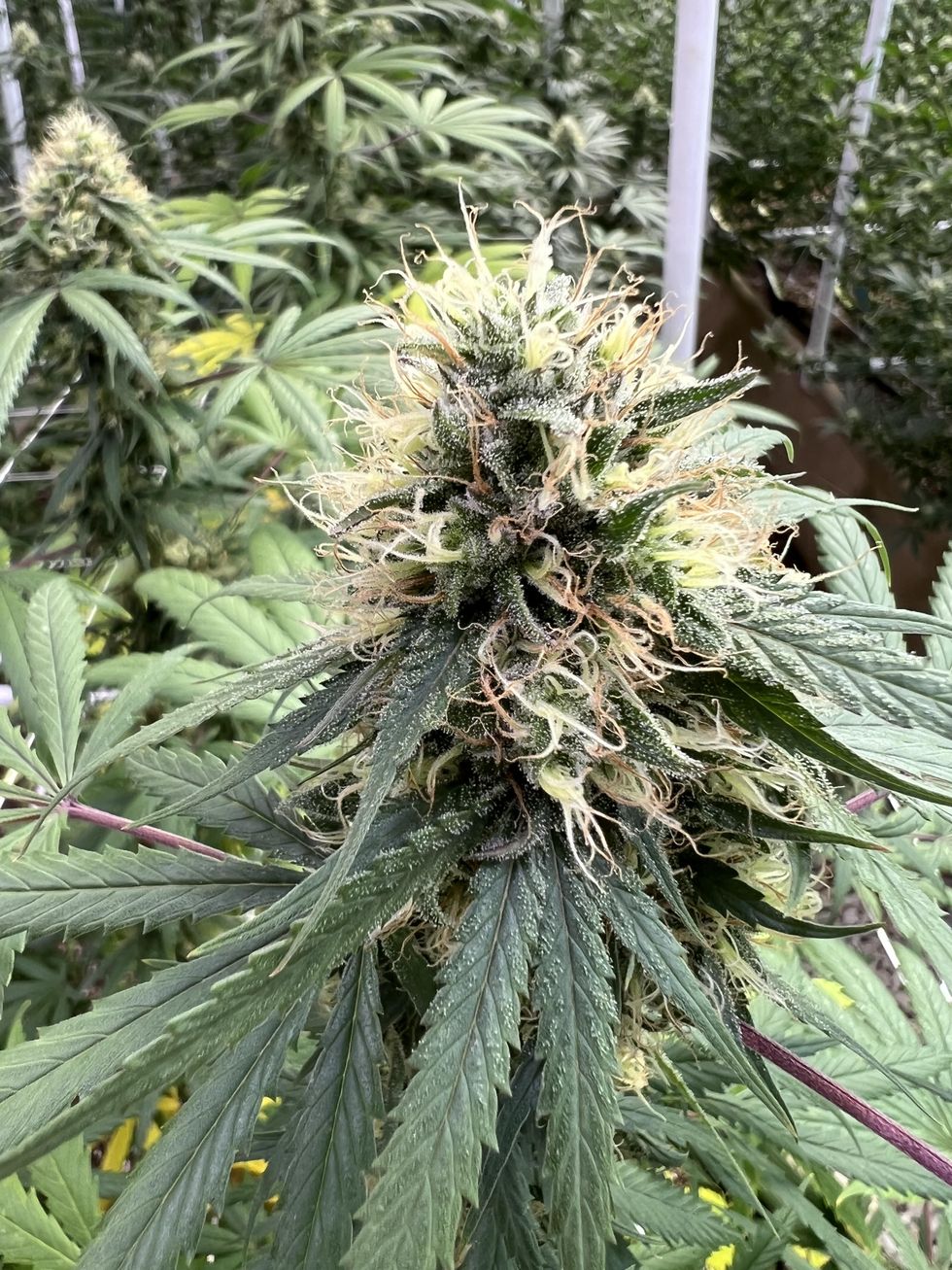State grapples with cannabis legalization

“Papaya Punch” is a popular item at The Pass in Sheffield, Mass.
Photo by Hunter O. Lyle

The first in a series on the legalization of cannabis in Connecticut.
LAKEVILLE — Change is coming to Connecticut with the legalization of a recreational drug that was once part of an underground culture, and it’s a momentous step for a state that as recently as 10 years ago continued to honor its Puritan heritage by barring liquor stores from opening on Sundays.
A little more than a year ago, Gov. Ned Lamont signed a bill allowing for the sale and possession of recreational marijuana, known in the trade as “adult-use cannabis.” Nine years earlier, then-Gov. Dannel Malloy had signed a bill allowing for the sale of marijuana prescribed by a physician for medical purposes.
Marijuana as medicine has been less controversial than recreational, as evidenced by the fact that only a handful of mostly conservative states such as Mississippi and Idaho continue to prohibit it. Still, the legalization of adult-use cannabis in progressive Connecticut did not happen overnight. Possession of small amounts was decriminalized in 2011 and an initial effort to legalize it died in 2018.
Unless it’s carefully planned in advance, the legalization of adult-use cannabis typically prompts a mad rush among the states as officials scramble to figure out how to regulate the cultivation and sale of a substance that, on the federal level, remains a Schedule 1 narcotic on a par with heroin, LSD and mescaline.
Until recently, almost all the states that legalized adult-use cannabis had done so through ballot initiatives. That’s mostly because elected officials were hesitant to leave their fingerprints on legalization, lest something go terribly wrong. So they were willing to let the people decide.
Except for legislatively referred constitutional amendments, Connecticut has no such mechanism for putting issues before voters in the form of a referendum, so it was up to the General Assembly to pass legislation, which it did last year. Some key Democrats withheld support for the measure unless it included provisions for “social equity.” More on that later.
For guidance and, in an effort to avoid mistakes already made elsewhere, Connecticut looked to other states that had already legalized the substance. As cannabis aficionados in the Nutmeg State are aware, the cultivation, sale and use of recreational cannabis-related products was legalized in neighboring Massachusetts through a 2016 ballot initiative. The measure passed by almost 7.5 percentage points statewide and by roughly 30 points in neighboring towns to our north such as Great Barrington and Egremont. Implementation of the new law was left to the hastily created state Cannabis Control Commission (CCC).
In Connecticut, officials opted against creating a stand-alone commission to regulate the industry. Instead, the state Department of Consumer Protection (DCP) was charged with regulating and licensing cannabis businesses. The DCP says it expects retail sales of adult-use cannabis to begin in Connecticut in late 2022 or early 2023.
For its part, the Bay State was able to learn from Colorado, which had legalized adult-use in 2012. What officials have found in both Massachusetts and Connecticut is that the barrier to entry into the business nationwide is quite high. Because cannabis remains illegal on the federal level, most banks will not loan money to cannabis entrepreneurs for fear of losing their federal charters. One Boston-area cannabis investor told the Boston Globe it takes at least $1 million to get started in the retail cannabis sector.
As a result, officials in Massachusetts were concerned that those who had been disproportionately affected by cannabis prohibition — mostly people in communities of color — would be among the least likely to obtain commercial financing.
The CCC subsequently created the Social Equity Program, the goal of which is to “ensure that people from communities that have been disproportionately harmed by marijuana law enforcement are included in the new legal marijuana industry.”
In Connecticut, officials have created the Social Equity Council, which says on its website that it was “developed in order to make sure the adult-use cannabis program is grown equitably, and ensures that funds from the adult-use cannabis program are brought back to the communities hit hardest by the war on drugs.”
Last month the DCP allowed 16 cannabis cultivators to move forward with applications that had been previously approved by the Social Equity Council. The licensing fee is a whopping $3 million but those funds will be allocated into the state’s social equity fund to help social equity applicants.
The state has identified more than 200 census tracts that qualify as “disproportionately impacted areas,” including 12 in Litchfield County (11 in Torrington and one in Morris) but none yet in the far Northwest Corner towns of the Region One School District, according to the DCP website.
There is also the matter of cannabis cultivation needed to supply demand from retail outlets and consumers. Connecticut took a cue from Massachusetts, as officials here amended state statutes defining agriculture.
In what is surely the first of more to come, one social equity applicant, Hartford Cannabis Company, last week filed a lawsuit against the DCP, claiming it had been “wrongfully denied a provisional cultivator’s license” earlier this month.
“The terms ‘agriculture’ and ‘farming’ do not include the cultivation of cannabis,” the state Department of Agriculture announced not long after the General Assembly voted to legalize adult use.
This means that so-called “right-to-farm” communities may regulate cannabis production, and neighbors who have the standing may engage in litigation to stop it. Since the mid 1980s, at least a dozen towns, mostly in the rural eastern portion of Connecticut, have passed right-to-farm ordinances that broadly protect those who engage in agricultural activities from certain nuisance lawsuits and regulations regarding odors, noises and other nuisances associated with traditional farming. Cannabis cultivators do not enjoy those protections.
Next week: What are towns in the Northwest Corner doing to prepare for the retail and cultivation of adult-use cannabis?
Ava Segalla, Housatonic Valley Regional High School's all-time leading goal scorer, has takes a shot against Coventry in the Class S girls soccer tournament quarterfinal game Friday, Nov. 7.
FALLS VILLAGE — Housatonic Valley Regional High School’s girls soccer team is headed to the semifinals of the state tournament.
The Mountaineers are the highest seeded team of the four schools remaining in the Connecticut Interscholastic Athletic Conference Class S playoff bracket.
HVRHS (3) will play Morgan High School (10) in the semifinals. On the other side of the bracket, Canton High School (4) will play Old Saybrook High School (9). The winners of both games will meet in the Class S championship game.
To start the tournament, HVRHS earned a first-round bye and then had home-field advantage for the second-round and quarterfinal games.

In the second round Tuesday, Nov. 4, HVRHS won 4-3 against Stafford High School (19) in overtime. Ava Segalla scored three goals for Housatonic, including the overtime winner, and Lyla Diorio scored once. Bella Coporale scored twice for Stafford and Gabrielle Fuller scored once.
HVRHS matched up against Coventry High School (11) in the quarterfinal round Friday, Nov. 7. In the 2024 tournament, Coventry eliminated the Mountaineers in the second round.

Revenge was served in 2025 with a 4-2 win for HVRHS. Segalla scored her second hat trick of the tournament and Georgie Clayton scored once. Coventry’s goals came from Jianna Foran and Savannah Blood.
“The vibes are great,” said HVRHS Principal Ian Strever at the quarterfinal game.

The semifinal against Morgan will be played Wednesday, Nov. 12, on neutral ground at Newtown High School.
If HVRHS wins, it will mark the girls soccer team’s first appearance in the Class S title game since 2014.
Morgan was the runner-up in last year’s Class S girls soccer tournament, losing in penalty kicks to Coginchaug High School.

Legal Notice
The Planning & Zoning Commission of the Town of Salisbury will hold a Public Hearing on Special Permit Application #2025-0303 by owner Camp Sloane YMCA Inc to construct a detached apartment on a single family residential lot at 162 Indian Mountain Road, Lakeville, Map 06, Lot 01 per Section 208 of the Salisbury Zoning Regulations. The hearing will be held on Monday, November 17, 2025 at 5:45 PM. There is no physical location for this meeting. This meeting will be held virtually via Zoom where interested persons can listen to & speak on the matter. The application, agenda and meeting instructions will be listed at www.salisburyct.us/agendas/. The application materials will be listed at www.salisburyct.us/planning-zoning-meeting-documents/. Written comments may be submitted to the Land Use Office, Salisbury Town Hall, 27 Main Street, P.O. Box 548, Salisbury, CT or via email to landuse@salisburyct.us. Paper copies of the agenda, meeting instructions, and application materials may be reviewed Monday through Thursday between the hours of 8:00 AM and 3:30 PM at the Land Use Office, Salisbury Town Hall, 27 Main Street, Salisbury CT.
Salisbury Planning & Zoning Commission
Martin Whalen, Secretary
11-06-25
11-13-25
Notice of Decision
Town of Salisbury
Planning & Zoning Commission
Notice is hereby given that the following action was taken by the Planning & Zoning Commission of the Town of Salisbury, Connecticut on October 20, 2025:
8-24 referral was deemed consistent with the Plan of Conservation and Development - For the use of town-owned land at 20 Salmon Kill Road, Salisbury for housing, recreation, and conservation. The property is shown on Salisbury Assessor’s Map 11 as Lot 26.
Any aggrieved person may appeal these decisions to the Connecticut Superior Court in accordance with the provisions of Connecticut General Statutes §8-8.
Town of Salisbury
Planning &
Zoning Commission
Martin Whalen, Secretary
11-06-25
Notice of Decision
Town of Salisbury
Inland Wetlands & Watercourses Commission
Notice is hereby given that the following actions were taken by the Inland Wetlands & Watercourses Commission of the Town of Salisbury, Connecticut on October 27, 2025:
Exempt - Application IWWC-25-75 by Elaine Watson to install a 4’ by 45’ removable dock adjacent to the high-water mark of Lake Wononscopomuc. The property is shown on Salisbury Assessor’s map 47 lot 11 and is a vacant parcel located between 123 & 137 Sharon Road, across from and associated with 126 Sharon Road. The owners of the property are Paul and Elaine Watson.
Approved with the condition that any additional permits required for this project are filed with the Land Use Office - Application IWWC-25-74 by Richard Riegel, Principal of Lime Rock Park II, LLC to reinforce compromised river bank and implement riparian restoration in partnership with Trout Unlimited. The property is shown on Salisbury Assessor’s map 04 lot 16 and is known as 497 Lime Rock Road, Lakeville. The owner of the property is Lime Rock Park II, LLC.
Approved - Application IWWC-25-72 by George Johannesen of Allied Engineering Associates, Inc. for an addition to the existing house, construct garage, relocate driveway, landscaping. The property is shown on Salisbury Assessor’s map 08 lot 03 and is known as 396 Salmon Kill Road, Lakeville. The owners of the property are Randall Allen and Margaret Holden.
Approved subject to conditions recommended by the Town Consulting Engineer and the relinquishment of permit 2024-IW-036 - Application IWWC-25-69 by Bob Stair to construct an addition to the existing house and driveway in the upland review area. The property is shown on Salisbury Assessor’s map 67 lot 07 and is known as 300 Between the Lakes Road, Salisbury. The owner of the property is 280 BTLR LLC.
Approved subject to conditions recommended by the Town Consulting Engineer - Application IWWC-25-73 by Hotchkiss School (Michael J. Virzi) for a restoration plan for the existing temporary dining building at the Hotchkiss School. The property is shown on Salisbury Assessor’s map 06 lot 09 and is known as 22 Lime Rock Road, Lakeville. The owner of the property is Hotchkiss School.
Any aggrieved person may appeal this decision to the Connecticut Superior Court in accordance with the provisions of Connecticut General Statutes §22a-43(a) & §8-8.
11-06-25
NOTICE TO CREDITORS
ESTATE OF
DEBRA ANN WHITBECK
Late of North Canaan
(25-00419)
The Hon. Jordan M. Richards, Judge of the Court of Probate, District of Litchfield Hills Probate Court, by decree dated October 16, 2025, ordered that all claims must be presented to the fiduciary at the address below. Failure to promptly present any such claim may result in the loss of rights to recover on such claim.
The fiduciary is:
Donna L. Cooke
65 Orchard Street
North Canaan, CT 06018
Megan M. Foley
Clerk
11-06-25
NOTICE TO CREDITORS
ESTATE OF
THOMAS CROSBY DOANE
Late of North Canaan
(25-00388)
The Hon. Jordan M. Richards, Judge of the Court of Probate, District of Litchfield Hills Probate Court, by decree dated October 9, 2025, ordered that all claims must be presented to the fiduciary at the address below. Failure to promptly present any such claim may result in the loss of rights to recover on such claim.
The fiduciary is:
Jase Doane
5 Clearwater Lane
East Hampton, CT 06424
Megan M. Foley
Clerk
11-06-25
Weatogue Stables has an opening: for a full time team member. Experienced and reliable please! Must be available weekends. Housing a possibility for the right candidate. Contact Bobbi at 860-307-8531.
Deluxe Professional Housecleaning: Experience the peace of a flawlessly maintained home. For premium, detail-oriented cleaning, call Dilma Kaufman at 860-491-4622. Excellent references. Discreet, meticulous, trustworthy, and reliable. 20 years of experience cleaning high-end homes.
Hector Pacay Service: House Remodeling, Landscaping, Lawn mowing, Garden mulch, Painting, Gutters, Pruning, Stump Grinding, Chipping, Tree work, Brush removal, Fence, Patio, Carpenter/decks, Masonry. Spring and Fall Cleanup. Commercial & Residential. Fully insured. 845-636-3212.
SNOW PLOWING: Be Ready! Local. Sharon/Millerton/Lakeville area. Call 518-567-8277.
Local editor with 30 years experience offering professional services: to writers working on a memoir or novel, or looking for help to self publish. Hourly rates. Call 917-331 2201.
PUBLISHER’S NOTICE: Equal Housing Opportunity. All real estate advertised in this newspaper is subject to the Federal Fair Housing Act of 1966 revised March 12, 1989 which makes it illegal to advertise any preference, limitation, or discrimination based on race, color religion, sex, handicap or familial status or national origin or intention to make any such preference, limitation or discrimination. All residential property advertised in the State of Connecticut General Statutes 46a-64c which prohibit the making, printing or publishing or causing to be made, printed or published any notice, statement or advertisement with respect to the sale or rental of a dwelling that indicates any preference, limitation or discrimination based on race, creed, color, national origin, ancestry, sex, marital status, age, lawful source of income, familial status, physical or mental disability or an intention to make any such preference, limitation or discrimination.
Sharon, 2 Bd/ /2bth 1900 sqft home: on private Estate-Gbg, Water, Mow/plow included. utilities addtl. Please call: 860-309-4482.
Falls Village, CT
Saturday November 8 Tag Sale in the Barn: 91 Main Street in Falls Village 10 to 3 pm. Please Park in town parking available along Main St. Tools, wood working tools, bench, furniture, antique doors, out door planters, Halloween and Christmas decorations and much more.
